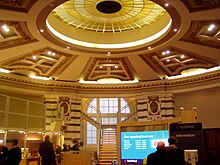|
|
|---|
Monday, October 25, 2010
Top 10 Largest Bank In The World-
SOME FAMOUS ENGLISH BANKS.; Recent Amalgamations -- The History of One or Two of the Oldest Concerns -- Their Founders -- Interesting Checks Drawn.
| This is a list of famous bank robberies, bank robbers and gangs involved in .... Baker Street robbery, 1971, London, politically sensitive material taken . |
This live streaming London webcam is on the south bank of the River Thames in ... well known and famous London landmarks on both sides of the River Thames.
Famous in Bank on Qype! Get Real Opinions, Photos, and Comments for Businesses like London Bridge.
For other uses, see Bank Ranking here.
Riggs National Bank - Washington D.C. - 1900 - 1920 - Famous Bank Vignette .... International opened two new offices - one in London and the other in Jersey
Famous in Bank on Qype! Get Real Opinions, Photos, and Comments for Businesses like London Bridge.
For other uses, see Bank Ranking here.
Riggs National Bank - Washington D.C. - 1900 - 1920 - Famous Bank Vignette .... International opened two new offices - one in London and the other in Jersey
"Banker" redirects here. For other uses, see Banker report.
"Bankers" redirects here. For the economics book, see The Bankers.
17, (15), Barclays Bank PLC, London, UK. *397668, +16.17%, 2409.35, 31.12.99. 18
17, (15), Barclays Bank PLC, London, UK. *397668, +16.17%, 2409.35, 31.12.99. 18
| Banking | |
| Types of bank Central bank Advising bank Commercial bank Community development bank Credit union Custodian bank Depository bank German public bank Investment bank Industrial bank Islamic banking Merchant bank Mutual bank Mutual savings bank National bank Offshore bank Private bank Savings bank Swiss bank | |
| Deposit accounts Savings account Transactional account Money market account Time deposit | |
| ATM card Debit card Credit card | |
| Electronic funds transfer Automated Clearing House Electronic bill payment Giro Wire transfer | |
| Banking terms Anonymous banking Automatic teller machine Loan Money creation Substitute check | |
| List of banks | |
Finance series Financial market Financial market participants Corporate finance Personal finance Public finance Banks and Banking Financial regulation | |
| Finance |
|---|
Financial markets |
Financial instruments |
Personal finance |
Financial regulation |
A bank is a financial intermediary that accepts deposits and channels those deposits into lending activities, either directly or through capital markets. A bank connects customers with capital deficits to customers with capital surpluses.
Banking is generally a highly regulated industry, and government restrictions on financial activities by banks have varied over time and location. The current set of global bank capital standards are called Basel II. In some countries such as Germany, banks have historically owned major stakes in industrial corporations while in other countries such as the United States banks are prohibited from owning non-financial companies. In Japan, banks are usually the nexus of a cross-share holding entity known as the keiretsu. In Iceland banks had very light regulation prior to the 2008 collapse.
The oldest bank still in existence is Monte dei Paschi di Siena, headquartered in Siena, Italy, which has been operating continuously since 1472.
Top 10 Largest Bank In The World-
BNP Paribas (BNP) – This French bank comes in at No. 1 with $3.21 trillion in assets. BNP is one of the largest global banking networks in the world with operations in 84 countries. BNP has four domestic retail banking markets located in France, Italy, Belgium and Luxembourg. In April 2009, as a result of BNP’s 75% purchase of Fortis Bank, the Belgian bank is now the largest Eurozone deposit holder.
Royal Bank of Scotland (RBS) Group – RBS Group ranks as the number two bank in terms of assets held. Currently, the British government is the largest owner of the bank. As a result of severe losses and the conditions of a government backed bailout, RBS Group has halted dividend payments. RBS Group is the largest banking group in Scotland and operates a wide variety of banking brands including personal and business banking, private banking, insurance and corporate finance throughout its operations located in Europe, North America and Asia. As of May 2010, RBS Group had $2.99 trillion in assets.
Barclays PLC (Barclay’s) – Barclays, with $2.54 trillion in assets, is a British financial services firm operating worldwide. It is a holding company listed on the London and New York Stock exchanges, is a component of the FTSE 100 Index and until 2008 was also listed on the Tokyo Stock Exchange. Barclays operates through branches, offices and subsidiaries in the United Kingdom and overseas and provides retail banking, credit card, corporate and investment banking and wealth management services. Its two major business groups are: Global Retailing and Commercial Banking, and Investment Banking and Investment Management.
Deutsche Bank – Deutsche Bank, the largest German bank with $2.43 trillion in assets, has a strong presence throughout Germany and Europe and continues to grow in North America and Asia. As of March 31, 2010, Deutsche Bank had approximately 2,000 branches in 72 countries.
HSBC Bank – HSBC Bank has more than 460 bank branches throughout the United States, with the majority (380) in New York State. Coming in at number 5 on our list of the biggest banks with $2.42 trillion in assets, HSBC offers its 4 million customers access to global markets through its personal financial services, private banking, retail banking, commercial banking and global banking and market segments.
Credit Agricole – The second and final French bank on the top 10 list with $2.3 trillion in assets, Credit Agricole is a retail banking leader in France and throughout Europe. It is part of the CAC 40, a benchmark French stock market index. It has 11,500 branches throughout the world, more than 160,000 employees and 59 million customers in 70 countries.
Bank of America (BAC) – BAC is the largest bank holding company in the United States, by assets, with $2.25 trillion. The company serves clients all over the world and has a relationship with 99% of the U.S. Fortune 500 companies. In 2008, BAC acquired Merrill Lynch making it the world’s largest wealth manager. It is listed on the New York Stock Exchange (NYSE) and is part of the S&P 500 Index and the Dow Jones Industrial Average.
Mitsubishi UFJ Financial Group (Mitsubishi) – With $2.07 trillion in assets, Mitsubishi is Japan’s largest bank holding/financial services group. Part of the Mitsubishi Corporation, the company provides a wide variety of financial and investment services including commercial banking, trust banking, international finance, and assets management services.
J.P. Morgan Chase – One of the two so-called “too big to fail” banks, along with Bank of America, J.P. Morgan Chase is the 10th largest bank in the world with $2.02 trillion in assets. The company provides products and services to its clients in 100 countries including asset management, investment banking, private banking, treasury and securities services, and commercial banking. J.P. Morgan Chase is traded on the NYSE under ticker symbol JPM.
UBS AG – Rounding out the top ten banks in the world by asset type is UBS AG with $1.8 trillion in assets. Headquartered in Zurich and Basel, UBS provides financial services to private, corporate and institutional clients. UBS has a foothold in major financial centers all over the world and has offices in more than 50 countries.
History-
Main article: History of banking
Banking in the modern sense of the word can be traced to medieval and early Renaissance Italy, to the rich cities in the north like Florence, Venice and Genoa. The Bardi and Peruzzi families dominated banking in 14th century Florence, establishing branches in many other parts of Europe. Perhaps the most famous Italian bank was the Medici bank, set up by Giovanni Medici in 1397. The earliest known state deposit bank, Banco di San Giorgio (Bank of St. George), was founded in 1407 at Genoa, Italy.
Banks can be traced back to ancient times even before money when temples were used to store commodities. During the 3rd century AD, banks in Persia and other territories in the Persian Sassanid Empire issued letters of credit known as Ṣakks.[citation needed] Muslim traders are known to have used the cheque or ṣakk system since the time of Harun al-Rashid (9th century) of the Abbasid Caliphate. In the 9th century, a Muslim businessman could cash an early form of the cheque in China drawn on sources in Baghdad,[verification needed] a tradition that was significantly strengthened in the 13th and 14th centuries, during the Mongol Empire.[citation needed] Fragments found in the Cairo Geniza indicate that in the 12th century cheques remarkably similar to our own were in use, only smaller to save costs on the paper. They contain a sum to be paid and then the order "May so and so pay the bearer such and such an amount". The date and name of the issuer are also apparent.
Origin of the word-

Silver drachm coin from Trapezus, 4th century BC
The word bank was borrowed in Middle English from Middle French banque, from Old Italian banca, from Old High German banc, bank "bench, counter". Benches were used as desks or exchange counters during the Renaissance by Florentine bankers, who used to make their transactions atop desks covered by green tablecloths.
The earliest evidence of money-changing activity is depicted on a silver Greek drachm coin from ancient Hellenic colony Trapezus on the Black Sea, modern Trabzon, c. 350–325 BC, presented in the British Museum in London. The coin shows a banker's table (trapeza) laden with coins, a pun on the name of the city. In fact, even today in Modern Greek the word Trapeza (Τράπεζα) means both a table and a bank.
Definition-
The definition of a bank varies from country to country. See the relevant country page (below) for more information.
Under English common law, a banker is defined as a person who carries on the business of banking, which is specified as:
- conducting current accounts for his customers
- paying cheques drawn on him, and
- collecting cheques for his customers.

Banco de Venezuela in Coro.
In most common law jurisdictions there is a Bills of Exchange Act that codifies the law in relation to negotiable instruments, including cheques, and this Act contains a statutory definition of the term banker: banker includes a body of persons, whether incorporated or not, who carry on the business of banking' (Section 2, Interpretation). Although this definition seems circular, it is actually functional, because it ensures that the legal basis for bank transactions such as cheques does not depend on how the bank is organised or regulated.
The business of banking is in many English common law countries not defined by statute but by common law, the definition above. In other English common law jurisdictions there are statutory definitions of the business of banking or banking business. When looking at these definitions it is important to keep in mind that they are defining the business of banking for the purposes of the legislation, and not necessarily in general. In particular, most of the definitions are from legislation that has the purposes of entry regulating and supervising banks rather than regulating the actual business of banking. However, in many cases the statutory definition closely mirrors the common law one. Examples of statutory definitions:
- "banking business" means the business of receiving money on current or deposit account, paying and collecting cheques drawn by or paid in by customers, the making of advances to customers, and includes such other business as the Authority may prescribe for the purposes of this Act; (Banking Act (Singapore), Section 2, Interpretation).
- "banking business" means the business of either or both of the following:
- receiving from the general public money on current, deposit, savings or other similar account repayable on demand or within less than [3 months] ... or with a period of call or notice of less than that period;
- paying or collecting cheques drawn by or paid in by customers
Since the advent of EFTPOS (Electronic Funds Transfer at Point Of Sale), direct credit, direct debit and internet banking, the cheque has lost its primacy in most banking systems as a payment instrument. This has led legal theorists to suggest that the cheque based definition should be broadened to include financial institutions that conduct current accounts for customers and enable customers to pay and be paid by third parties, even if they do not pay and collect cheques.
Banking:
Standard activities-

Large door to an old bank vault.
Banks act as payment agents by conducting checking or current accounts for customers, paying cheques drawn by customers on the bank, and collecting cheques deposited to customers' current accounts. Banks also enable customer payments via other payment methods such as telegraphic transfer, EFTPOS, and ATM.
Banks borrow money by accepting funds deposited on current accounts, by accepting term deposits, and by issuing debt securities such as banknotes and bonds. Banks lend money by making advances to customers on current accounts, by making installment loans, and by investing in marketable debt securities and other forms of money lending.
Banks provide almost all payment services, and a bank account is considered indispensable by most businesses, individuals and governments. Non-banks that provide payment services such as remittance companies are not normally considered an adequate substitute for having a bank account.
Banks borrow most funds from households and non-financial businesses, and lend most funds to households and non-financial businesses, but non-bank lenders provide a significant and in many cases adequate substitute for bank loans, and money market funds, cash management trusts and other non-bank financial institutions in many cases provide an adequate substitute to banks for lending savings to.
Business model-
A bank can generate revenue in a variety of different ways including interest, transaction fees and financial advice. The main method is via charging interest on the capital it lends out to customers. The bank profits from the differential between the level of interest it pays for deposits and other sources of funds, and the level of interest it charges in its lending activities.
This difference is referred to as the spread between the cost of funds and the loan interest rate. Historically, profitability from lending activities has been cyclical and dependent on the needs and strengths of loan customers and the stage of the economic cycle. Fees and financial advice constitute a more stable revenue stream and banks have therefore placed more emphasis on these revenue lines to smooth their financial performance.
In the past 20 years American banks have taken many measures to ensure that they remain profitable while responding to increasingly changing market conditions. First, this includes the Gramm-Leach-Bliley Act, which allows banks again to merge with investment and insurance houses. Merging banking, investment, and insurance functions allows traditional banks to respond to increasing consumer demands for "one-stop shopping" by enabling cross-selling of products (which, the banks hope, will also increase profitability).
Second, they have expanded the use of risk-based pricing from business lending to consumer lending, which means charging higher interest rates to those customers that are considered to be a higher credit risk and thus increased chance of default on loans. This helps to offset the losses from bad loans, lowers the price of loans to those who have better credit histories, and offers credit products to high risk customers who would otherwise be denied credit.
Third, they have sought to increase the methods of payment processing available to the general public and business clients. These products include debit cards, prepaid cards, smart cards, and credit cards. They make it easier for consumers to conveniently make transactions and smooth their consumption over time (in some countries with underdeveloped financial systems, it is still common to deal strictly in cash, including carrying suitcases filled with cash to purchase a home).
However, with convenience of easy credit, there is also increased risk that consumers will mismanage their financial resources and accumulate excessive debt. Banks make money from card products through interest payments and fees charged to consumers and transaction fees to companies that accept the cards. This helps in making profit and facilitates economic development as a whole.
Products-

A former building society, now a modern retail bank in Leeds, West Yorkshire.

An interior of a branch of National Westminster Bank on Castle Street, Liverpool
Economic functions-
The economic functions of banks include:
- Issue of money, in the form of banknotes and current accounts subject to cheque or payment at the customer's order. These claims on banks can act as money because they are negotiable and/or repayable on demand, and hence valued at par. They are effectively transferable by mere delivery, in the case of banknotes, or by drawing a cheque that the payee may bank or cash.
- Netting and settlement of payments – banks act as both collection and paying agents for customers, participating in interbank clearing and settlement systems to collect, present, be presented with, and pay payment instruments. This enables banks to economise on reserves held for settlement of payments, since inward and outward payments offset each other. It also enables the offsetting of payment flows between geographical areas, reducing the cost of settlement between them.
- Credit intermediation – banks borrow and lend back-to-back on their own account as middle men.
- Credit quality improvement – banks lend money to ordinary commercial and personal borrowers (ordinary credit quality), but are high quality borrowers. The improvement comes from diversification of the bank's assets and capital which provides a buffer to absorb losses without defaulting on its obligations. However, banknotes and deposits are generally unsecured; if the bank gets into difficulty and pledges assets as security, to raise the funding it needs to continue to operate, this puts the note holders and depositors in an economically subordinated position.
- Maturity transformation – banks borrow more on demand debt and short term debt, but provide more long term loans. In other words, they borrow short and lend long. With a stronger credit quality than most other borrowers, banks can do this by aggregating issues (e.g. accepting deposits and issuing banknotes) and redemptions (e.g. withdrawals and redemptions of banknotes), maintaining reserves of cash, investing in marketable securities that can be readily converted to cash if needed, and raising replacement funding as needed from various sources (e.g. wholesale cash markets and securities markets).
Bank crisis-
Banks are susceptible to many forms of risk which have triggered occasional systemic crises. These include liquidity risk (where many depositors may request withdrawals in excess of available funds), credit risk (the chance that those who owe money to the bank will not repay it), and interest rate risk (the possibility that the bank will become unprofitable, if rising interest rates force it to pay relatively more on its deposits than it receives on its loans).
Banking crises have developed many times throughout history, when one or more risks have materialized for a banking sector as a whole. Prominent examples include the bank run that occurred during the Great Depression, the U.S. Savings and Loan crisis in the 1980s and early 1990s, the Japanese banking crisis during the 1990s, and the subprime mortgage crisis in the 2000s.
Size of global banking industry-
Assets of the largest 1,000 banks in the world grew by 6.8% in the 2008/2009 financial year to a record $96.4 trillion while profits declined by 85% to $115bn. Growth in assets in adverse market conditions was largely a result of recapitalisation. EU banks held the largest share of the total, 56% in 2008/2009, down from 61% in the previous year. Asian banks' share increased from 12% to 14% during the year, while the share of US banks increased from 11% to 13%. Fee revenue generated by global investment banking totalled $66.3bn in 2009, up 12% on the previous year.
The United States has the most banks in the world in terms of institutions (7,085 at the end of 2008) and possibly branches (82,000). This is an indicator of the geography and regulatory structure of the USA, resulting in a large number of small to medium-sized institutions in its banking system. As of Nov 2009, China's top 4 banks have in excess of 67,000 branches (ICBC:18000+, BOC:12000+, CCB:13000+, ABC:24000+) with an additional 140 smaller banks with an undetermined number of branches. Japan had 129 banks and 12,000 branches. In 2004, Germany, France, and Italy each had more than 30,000 branches—more than double the 15,000 branches in the UK.
Regulation-
Main article: Banking regulation
See also: Basel II
Currently in most jurisdictions commercial banks are regulated by government entities and require a special bank licence to operate.
Usually the definition of the business of banking for the purposes of regulation is extended to include acceptance of deposits, even if they are not repayable to the customer's order—although money lending, by itself, is generally not included in the definition.
Unlike most other regulated industries, the regulator is typically also a participant in the market, i.e. a government-owned (central) bank. Central banks also typically have a monopoly on the business of issuing banknotes. However, in some countries this is not the case. In the UK, for example, the Financial Services Authority licences banks, and some commercial banks (such as the Bank of Scotland) issue their own banknotes in addition to those issued by the Bank of England, the UK government's central bank.
Banking law is based on a contractual analysis of the relationship between the bank (defined above) and the customer—defined as any entity for which the bank agrees to conduct an account.
The law implies rights and obligations into this relationship as follows:
- The bank account balance is the financial position between the bank and the customer: when the account is in credit, the bank owes the balance to the customer; when the account is overdrawn, the customer owes the balance to the bank.
- The bank agrees to pay the customer's cheques up to the amount standing to the credit of the customer's account, plus any agreed overdraft limit.
- The bank may not pay from the customer's account without a mandate from the customer, e.g. a cheque drawn by the customer.
- The bank agrees to promptly collect the cheques deposited to the customer's account as the customer's agent, and to credit the proceeds to the customer's account.
Types of banks-
Banks' activities can be divided into retail banking, dealing directly with individuals and small businesses; business banking, providing services to mid-market business; corporate banking, directed at large business entities; private banking, providing wealth management services to high net worth individuals and families; and investment banking, relating to activities on the financial markets. Most banks are profit-making, private enterprises. However, some are owned by government, or are non-profit organizations.
Types of retail banks-

National Bank of the Republic, Salt Lake City 1908

ATM Al-Rajhi Bank

National Copper Bank, Salt Lake City 1911
- Commercial bank: the term used for a normal bank to distinguish it from an investment bank. After the Great Depression, the U.S. Congress required that banks only engage in banking activities, whereas investment banks were limited to capital market activities. Since the two no longer have to be under separate ownership, some use the term "commercial bank" to refer to a bank or a division of a bank that mostly deals with deposits and loans from corporations or large businesses.
- Community banks: locally operated financial institutions that empower employees to make local decisions to serve their customers and the partners.
- Community development banks: regulated banks that provide financial services and credit to under-served markets or populations.
- Postal savings banks: savings banks associated with national postal systems.
- Private banks: banks that manage the assets of high net worth individuals. Historically a minimum of USD 1 million was required to open an account, however, over the last years many private banks have lowered their entry hurdles to USD 250,000 for private investors.
- Offshore banks: banks located in jurisdictions with low taxation and regulation. Many offshore banks are essentially private banks.
- Savings bank: in Europe, savings banks take their roots in the 19th or sometimes even 18th century. Their original objective was to provide easily accessible savings products to all strata of the population. In some countries, savings banks were created on public initiative; in others, socially committed individuals created foundations to put in place the necessary infrastructure. Nowadays, European savings banks have kept their focus on retail banking: payments, savings products, credits and insurances for individuals or small and medium-sized enterprises. Apart from this retail focus, they also differ from commercial banks by their broadly decentralised distribution network, providing local and regional outreach—and by their socially responsible approach to business and society.
- Building societies and Landesbanks: institutions that conduct retail banking.
- Ethical banks: banks that prioritize the transparency of all operations and make only what they consider to be socially-responsible investments.
- A Direct or Internet-Only bank is a banking operation without any physical bank branches, conceived and implemented wholly with networked computers.
Types of investment banks-
- Investment banks "underwrite" (guarantee the sale of) stock and bond issues, trade for their own accounts, make markets, and advise corporations on capital market activities such as mergers and acquisitions.
- Merchant banks were traditionally banks which engaged in trade finance. The modern definition, however, refers to banks which provide capital to firms in the form of shares rather than loans. Unlike venture capital firms, they tend not to invest in new companies.
Both combined-
- Universal banks, more commonly known as financial services companies, engage in several of these activities. These big banks are very diversified groups that, among other services, also distribute insurance— hence the term bancassurance, a portmanteau word combining "banque or bank" and "assurance", signifying that both banking and insurance are provided by the same corporate entity.
Other types of banks-
- Central banks are normally government-owned and charged with quasi-regulatory responsibilities, such as supervising commercial banks, or controlling the cash interest rate. They generally provide liquidity to the banking system and act as the lender of last resort in event of a crisis.
- Islamic banks adhere to the concepts of Islamic law. This form of banking revolves around several well-established principles based on Islamic canons. All banking activities must avoid interest, a concept that is forbidden in Islam. Instead, the bank earns profit (markup) and fees on the financing facilities that it extends to customers.
- 31 Jul 2010 ... As shown below, European banks have appeared to fare better than their American counterparts. Below are the world's ten largest banks,
- 16 Aug 2010 ... Forbes declared it to be among the largest banks and companies in the world last year. HSBC is popular in Asia wherein its investments
- 25 Mar 2009 ... The data below is the world's biggest banks, ranked by The Banker based on their assets — plus their latest stock market value from Thomson .
10 Oct 2010 ... The Institute of International Finance, a group that represents 420 of the world's largest banks and finance houses, has issued yet another think.
From Wikipedia-
0 Comments:
Subscribe to:
Post Comments (Atom)

















